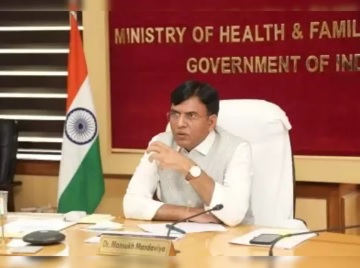As temperatures escalate, Union Health Ministry and NDMA Issue Joint-Advisory to States on measures to prevent Hospital Fires during Summer months
As temperatures escalate during the summer months, hospital fires become a significant threat. To prevent this, the Union Health Ministry and the National Disaster Management Authority (NDMA) have issued a joint advisory to all States/UTs underscoring the paramount importance of proactive measures in preventing such devastating incidents.

State Health Departments and State Disaster Management Authorities have been directed to work in close collaboration to ensure that all accredited hospitals within their jurisdiction take immediate action on the following:
• Thorough Inspections: Conduct comprehensive fire safety audit / on-site inspections of all hospitals to assess fire safety compliance. Ensure that fire-fighting systems, including fire alarms, fire smoke detectors, fire extinguishers, fire hydrants, and fire lifts, are present and fully functional.
• Electrical Load Audits: Address the critical issue of insufficient electrical load capacity. Hospitals must regularly conduct electrical load audits, particularly when adding new equipment or converting spaces into ICUs. Any identified discrepancies must be promptly rectified.
• Fire NOC Compliance: Hospitals must strictly adhere to regulatory requirements and obtain valid fire No-Objection Certificates (NOCs) from their respective state fire departments. Prioritize re-calibration of electrical loads in older buildings constructed before adopting fire safety norms.
A detailed set of instructions outlining the steps and measures to be undertaken by hospitals to ensure fire safety compliance have also been provided to Chief Secretaries of all States and UTs, recommending them to disseminate the information among all accredited hospitals.
Following are the instructions that need to be carried out to prevent occurrences of fire incidents in hospitals and other healthcare facilities:
1. Functional Fire-Fighting Systems: Hospitals must regularly inspect fire- fighting equipment such as fire extinguishers, hydrants, and alarms. This includes checking the expiry dates of extinguishers, ensuring hydrants are accessible and have adequate water pressure, and that fire alarms are operational and audible throughout the facility.
2. Regular Maintenance and Testing: Establish a maintenance schedule for all Are safety equipment. This should include monthly checks of fire extinguishers, quarterly tests of fire alarms and hydrants, and annual professional inspections to certify their effectiveness in accordance with relevant Indian Standards.
3. Regular Electrical Load Audits: Conduct electrical audits bi-annually to evaluate the hospital's power consumption, particularly in high-demand areas like ICUs. Upgrades or modifications should be assessed by a certified electrician to ensure they meet safety standards without overloading the system as per the National Electrical Code of India-2023.
4. Oxygen Safety: In areas with oxygen tanks or piped oxygen, implement strict no-smoking policies and controls on heat sources. Signage should clearly mark these areas, and staff should be trained on the risks associated with high- oxygen environments.
5. Installation of Smoke Detectors and Fire Alarms: Ensure fire smoke detectors and fire alarms are installed in all hospital areas, particularly in patient rooms, hallways, and common areas. Test these systems montly as stipulated in IS2189 and replace batteries annually or as needed.
6. Combustible Material Control: Audit materials used in hospital construction and furnishings to identify and replace combustible materials with non-combustible or fire-resistant alternatives, especially in-patient care areas.
7. Non-Combustible MateriaI for Electrical Ducts: Inspect electrical ducts to ensure they are sealed with materials like intumescent firestop sealants that prevent the spread of fire and smoke through openings.
8. Avoid Overloading Power Sources: Use power management systems to monitor electrical loads and prevent overloading. Ensure that multiple high- power devices are not connected to a single circuit. Regularly review power distribution to accommodate new equipment safely.
9. Installation of Water Sprinklers and Hosepipes: Fit critical areas, including ICUs and operation theatres, with automatic sprinkler systems and accessible hosepipes. These systems should be linked in sync with the fire alarm system to be activated in the event of a fire.
10. Strict Adherence to the National Building Code: Regularly review and update hospital infrastructure to comply with the latest fire safety standards outlined in the National Building Code 2016. This includes ensuring proper ventilation systems, fire-resistant doors, and emergency lighting in corridors and stairwells.
11. Obtaining Fire Safety NOC: Annually Renew the Fire Safety No-Objection Certificate as per State Fire Safety Rules from the local fire department. This includes submitting up-to-date fire safety plans and records of equipment maintenance and staff training.
12. Staff Training and Drills: Implement a continuous training program for all staff on fire prevention, emergency procedures, and the use of fire-fighting equipment. Conduct bi-annual fire drills, including evacuation drills, to ensure staff, doctors, and patients know how to respond in an emergency.
13. Evacuation Plans: Develop comprehensive evacuation plans that include clear, well-marked escape routes, emergency exits free of obstructions, and designated safe assembly areas. Plans should be displayed prominently throughout the hospital and in staff training programs. Each hospital has to formulate an SoP to be followed in case of a fire incident.
States/UTs have also been urged to conduct follow-up reviews to ensure the implementation of these critical safety measures.
